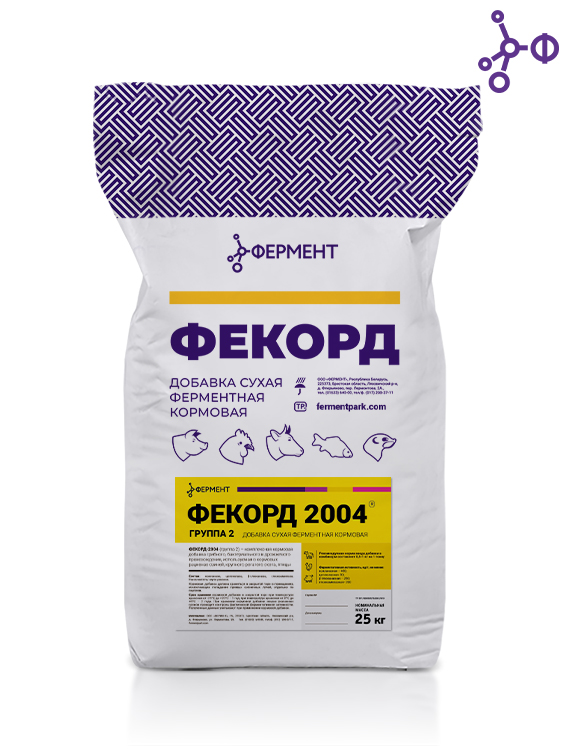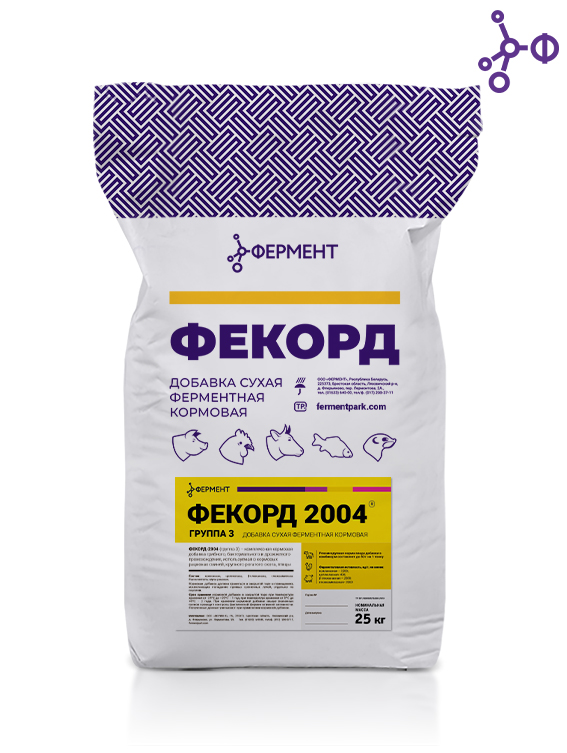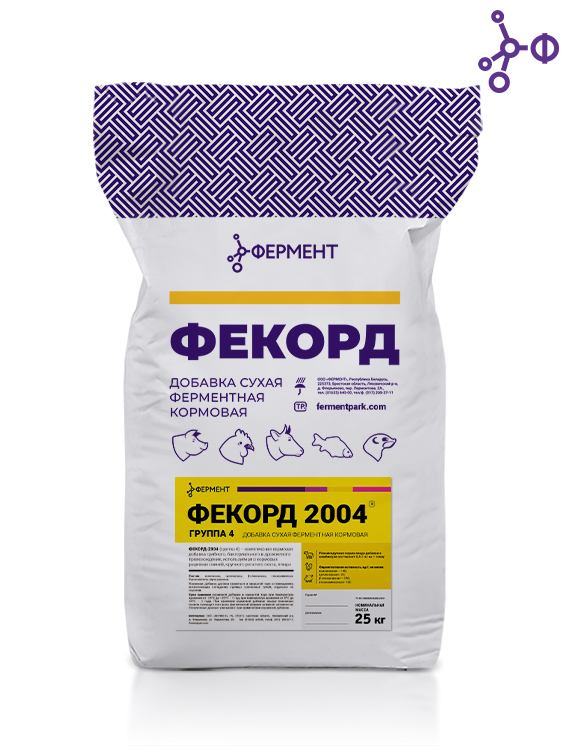- Ferment ООО
Dry enzyme feed additive:
-
"Fekord — 2004 — S" (group — 1);
-
"Fekord — 2004 — S" (group — 2);
-
"Fekord — 2004 — S" (group — 3);
- "Fekord — 2004 — S" (group — 4).
Composition
Enzymes: β-glucanase, xylanase, cellulase, α-amylase, glucoamylase, (producer strains - Trichoderma reesei and Aspergillus niger; Aspergillus oryzae, Bacillus amyloliquefaciens, Bacillus subtilis, Pichia Pastoris), filler (wheat or rye bran, wheat or rye flour, maltodextrin, zeolite, dietary salt, feed chalk).
Purpose
It is used in the feed rations of farm animals and poultry to improve the nutrient value by destruction of hydrocarbons which are difficult to hydrolyze.
Biological properties
-
destruction of anti-nutritional non-starch polysaccharides of the feed;
-
increase of energy nutrient value of the foodstuff;
-
destruction of grain endosperm cell walls and increase of cellular starch and protein endogenous enzymes availability in poultry and animals;
-
decrease of feed viscosity, improvement of nutrients digestibility and their absorption in the small intestine;
-
decrease of specific feed consumption per unit of the manufactured products;
- increase of livestock and poultry productivity.
Presentation
Cream white to light brown loose homogeneous powder.
How to use
For agricultural birds, pigs and bovine cattle of any age and sex groups, feed additives are recommended for inclusion in diets containing up to: 70% of wheat, 50% of rye, 75% of barley, 35% of oatmeal, 25% of wheat middling, 20% of sunflower oil meal, 60% of triticale, 65% of corn and other forage products with the increased content of non-starch polysaccharides (NPS) and phytine compounds.
Recommended rate of enzyme feed additives adding to the compound feed for pigs, cattle and poultry:
-
"Fekord — 2004 — S" (group 1) — 50 — 130 g per 1 ton of feed;
-
"Fekord — 2004 — S" (group 2) — 500 — 1000 g per 1 ton of feed;
-
"Fekord — 2004 — S" (group 3) — 30 — 50 g per 1 ton of feed;
-
"Fekord — 2004 — S" (group 4) — 500 — 1000 g per 1 ton of feed.
The additives are introduced at the plants producing premixtures, AVMA and compound feed or at the feed shops, by using current mixing technologies.
Stability
Feed additives remain effective at pH value from 2.0 to 9.0. They shall withstand temperature up to 95°С during granulation.
Advantages
-
destruction of antinutritive non-starch feed polysaccharides;
-
suppression of negative effect of these polysaccharides in gastrointestinal tract of animals and poultry;
-
decrease of feed viscosity, improvement of nutrients digestibility and their absorption in the small intestine;
-
destruction of the cell walls of the grain endosperm and increasing availability of cellular starch and protein for its own enzymes in poultry and animals;
-
reduction of specific feed consumption per unit of the products produced;
-
increase in livestock survival;
-
increased gain of weight of animals and poultry and increased poultry egg-laying capacity;
- increased availability of nutrients of silage and haylage.
Efficiency
Research has shown that using the additive in the swine mixed feed helps to improve the fattening properties of swine, to reduce the level of diarrhea diseases in piglets, to increase the degree of digestibility of carbohydrates, fats, and proteins, to increase the average daily weight gain by 9%, to reduce the feed costs per 1 kg of weight gain by 4.5%. In poultry farming, the use of Fekord-2004-S leads to an improvement in the morphological properties of the intestine and in the quality of droppings, a decrease in the number of dirty eggs, an increase in the body weight of broilers by 3-6%, an improvement in feed conversion rate by 6.2-12%, an increase in the intensity of egg production of hens by 3-8% and a reduction in the prime cost of eggs by 4.2-10.8%. The use of Fekord-2004-S in young cattle feeding contributes to an increase in fiber digestibility by 28%, a decrease in ammonia emissions, an increase in feed conversion rate by 11% and a decrease in dry matter consumption by 5%.





